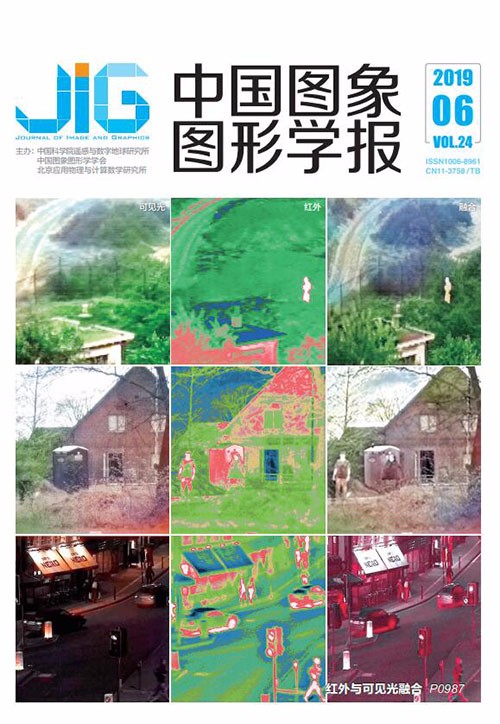
级联优化CNN的手指静脉图像质量评估
摘 要
目的 针对手动设计的手指静脉质量特征计算过程复杂、鲁棒性差、表达效果不理想等问题,提出了基于级联优化CNN(卷积神经网络)进行多特征融合的手指静脉质量评估方法。方法 以半自动化方式对手指静脉公开数据库MMCBNU_6000进行质量标注并用R-SMOTE(radom-synthetic minority over-sampling technique)算法平衡类别;将深度学习中的CNN结构应用到手指静脉质量评估并研究了不同的网络深度对表征手指静脉质量的影响;受到传统方法中将二值图像和灰度图像结合进行质量评估的启发,设计了两种融合灰度图像和二值图像的质量特征的模型:多通道CNN(MC-CNN)和级联优化CNN(CF-CNN),MC-CNN在训练和测试时均需要同时输入二值图像和灰度图像,CF-CNN在训练时分阶段输入二值图像和灰度图像,测试时只需输入灰度图像。结果 本文设计的3种简单CNN结构(CNN-K,K=3,4,5)在MMCBNU_6000数据库上对测试集图像的分类正确率分别为93.31%、93.94%、85.63%,以灰度图像和二值图像分别作为CNN-4的输入在MMCBNU_6000数据库上对测试集图像的分类正确率对应为93.94%、91.92%,MC-CNN和CF-CNN在MMCBNU_6000数据库上对测试集图像的分类正确率分别为91.44%、94.62%,此外,与现有的其他算法相比,CF-CNN在MMCBNU_6000数据库上对高质量测试图像、低质量测试图像、整体测试集图像的分类正确率均最高。结论 实验结果表明,基于CF-CNN学习到的融合质量特征比现有的手工特征和基于单一静脉形式学习到的特征表达效果更好,可以有效地对手指静脉图像进行高、低质量的区分。
关键词
Finger vein image quality assessment based on cascaded fine-tuning convolutional neural network
Zeng Junying, Chen Yao, Qin Chuanbo, Gan Junying, Zhai Yikui, Feng Wulin(Department of Information Engineering, Wuyi University, Jiangmen 529020, China) Abstract
Objective Finger vein recognition, an emerging biometric identification technology, has attracted the attention of numerous researchers. However, the quality of several collected finger vein images is not ideal due to individual differences, changes in the collection environment, and differences in the performance of acquisition equipment. In a finger vein recognition system, low-quality images seriously affect feature extraction and matching, resulting in poor identification performance of the system. In an application scene that requires the establishment of a standard template library of personal finger vein information in real life, registered low-quality images seriously influence the use of the finger vein standard template library. Therefore, correct quality assessment after collecting finger vein images is necessary to filter low-quality images and select high-quality ones to be inputted to a finger vein recognition system or to register a finger vein standard template library. To address the problems of considerable computation complexity, weak robustness, and unsatisfactory expression and the issue that the hand-crafted finger vein quality characteristic is sensitive to various factors, we develop a finger vein quality assessment method. These problems are addressed via multi-feature fusion, which is primarily based on the cascaded fine-tuning convolutional neural network (CNN). Method Finger vein image quality assessment methods based on deep learning require many labeled finger vein images. However, existing finger vein image public databases only provide finger vein images and do not mark them for quality. Thus, the first step should be labeling. In this study, the public finger vein database MMCBNU_6000 is labeled for quality representation in a semi-automated manner. This manner is based on the calculation of the number of veins in a finger vein image, followed by manual correction. Such an annotation method is more accurate, time saving, and cost effective than a pure manual annotation method. However, the collected low-quality finger vein images are fewer than the high-quality finger vein images in the actual scene; hence, the R-SMOTE algorithm is employed to balance all categories. The excellent capabilities of deep neural networks have been proven in the fields of image and speech. However, with regard to finger vein quality assessment, most existing methods are based on hand-crafted features, and only a few methods gain quality features via self-learning. In this study, the CNN structure in deep learning is applied to finger vein quality assessment, and the depth of the CNN framework is investigated for its contribution to quality representation. Deeper networks may not be good at representing the quality characteristics of finger vein images. The best network depth is confirmed after an experiment and used as the basis for subsequent research. Meanwhile, inspired by the combination of binary and grayscale images in traditional quality evaluation, two models, namely, multi-column CNN (MC-CNN) and cascaded fine-tuning CNN (CF-CNN), are designed to merge the quality features of grayscale and binary images. When MC-CNN is trained and tested, binary and grayscale images must be inputted together to the model. As for CF-CNN, binary and grayscale images are inputted to the model in stages during training, and only the grayscale image is inputted during testing. Notably, we input the binary finger vein image to the network and verify that the quality characteristics of the binary finger vein help distinguish high-and low-quality finger vein images. After verification, we obtain a basis to believe that the combination of binary and grayscale images through CNN produces remarkable results. Result Several experimental results for testing are set on the MMCBNU_6000 database. The classification accuracy rates of the CNN-K (K=3, 4, 5) designed in this study are 93.31%, 93.94%, and 85.63%, respectively; the classification accuracy rates of CNN-4 with grayscale and binary images as the input are 93.94% and 91.92%, and the classification accuracy rates of MC-CNN and CF-CNN are 91.44% and 94.62%, respectively. The experimental results of the simple CNN structure show that CNN-3 has the highest classification accuracy rate for high-quality images, CNN-5 has the highest classification accuracy rate for low-quality images, and CNN-4 has the highest classification accuracy rate for the entire test set. The experimental results of CNN-4 show that the grayscale vein form performs better than the binary vein form. Meanwhile, the experimental results of the complex CNN structure show that CF-CNN performs better than MC-CNN. Compared with other existing algorithms, CF-CNN has the highest classification accuracy rate for high-quality, low-quality, and overall test images on the MMCBNU_6000 database. Conclusion First, three simple CNN structures are designed and used for finger vein quality assessment. The comprehensive performance of CNN-4 is found to be better than that of CNN-3 and CNN-5, indicating that the network is not as deep as possible, and the structure of the network should be adjusted to suit the research questions. Second, the performance difference when gray and binary images are used for the same network is compared. Results show that both images characterize the vein quality to varying degrees. Finally, to fuse the quality features of grayscale and binary images, two fusion models (MC-CNN and CF-CNN) are proposed. CF-CNN, an end-to-end quality evaluation model of finger veins, is better than MC-CNN and has a simpler structure. In summary, our method demonstrates state-of-the-art performance and obtains better features than those from existing manual and single vein forms.
Keywords
finger vein quality assessment CNN(convolutional neural network) feature fusion MC-CNN (multi-column CNN) CF-CNN(cascaded fine-tuning CNN)
|



 中国图象图形学报 │ 京ICP备05080539号-4 │ 本系统由
中国图象图形学报 │ 京ICP备05080539号-4 │ 本系统由